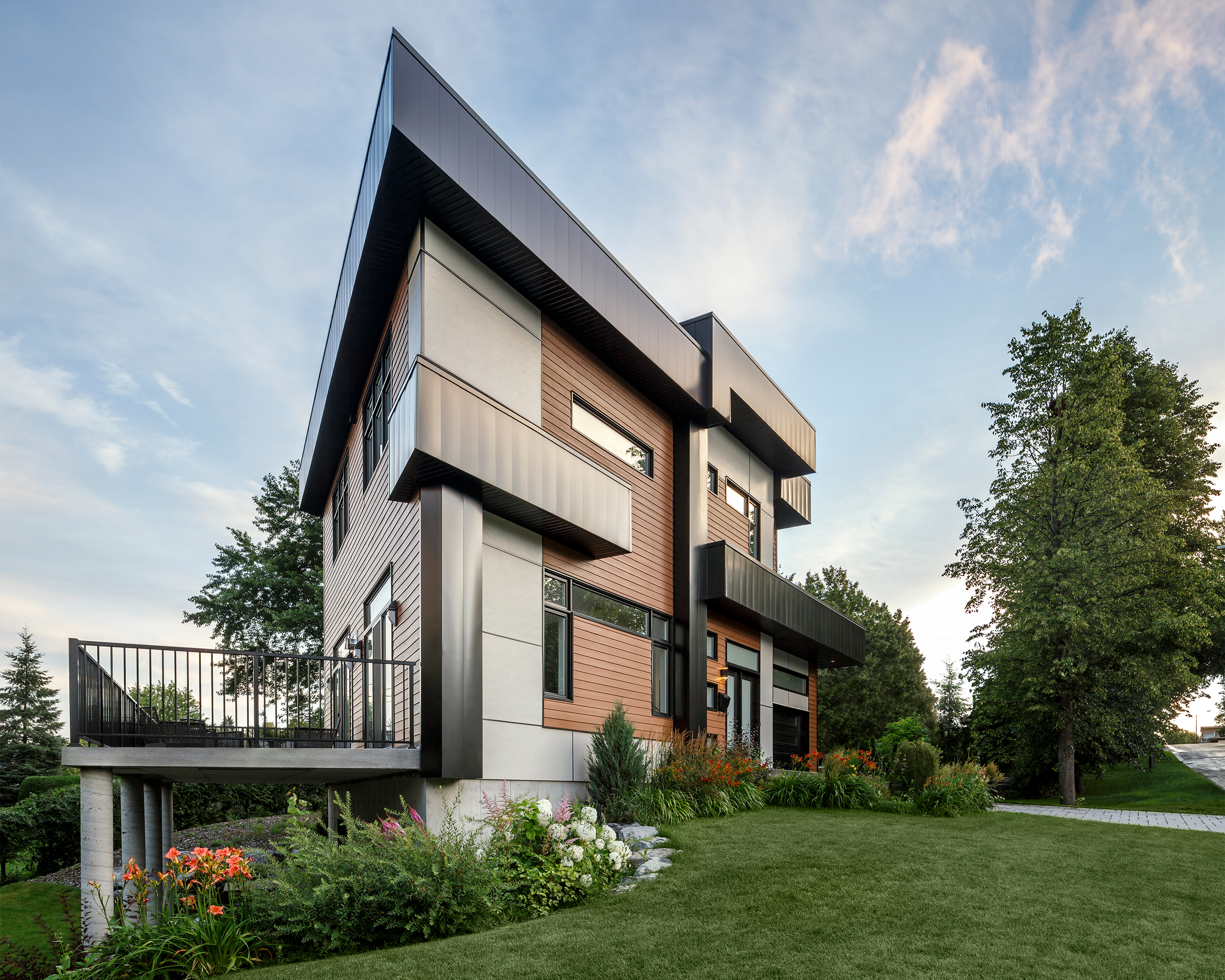The Canadian residential construction industry has seen a momentous shift toward personalization and expression over the past few years – and manufacturers have responded, increasing their product portfolios to match consumer preferences.
When we drive past a home, one of the first things we notice is colour and style. In fact, exterior cladding is one of the biggest contributors to curb appeal. Here, we survey select manufacturers to identify 2025’s hottest trends in residential siding and cladding.
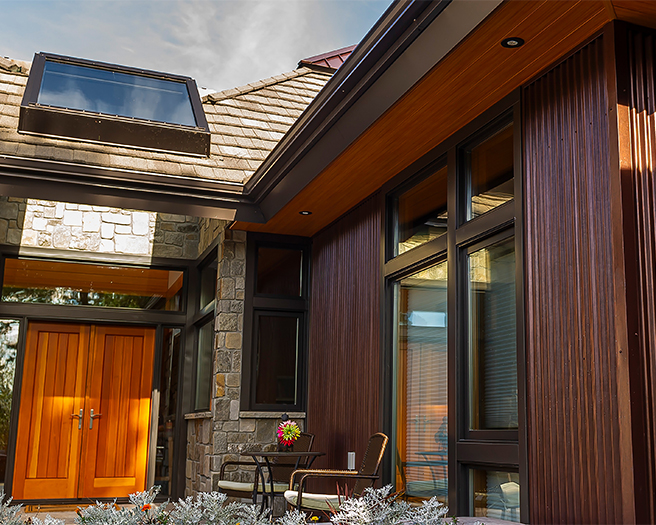
Photo courtesy of Westman Steel Industries
Westman Steel Industries
WGI Westman Group Inc. (WGI) was founded in Winnipeg in 1976. Westman Steel Industries is one of five WGI divisions, opening its seventh Canadian manufacturing plant in 2024.
Greg Gardenits is National Director of Sales and Marketing for Westman Steel Industries. He has spent over 11 years with the Canadian family-owned business and noted that Westman Steel is the country’s largest manufacturer in its category and a coast-to-coast supplier of metal roofing and cladding.
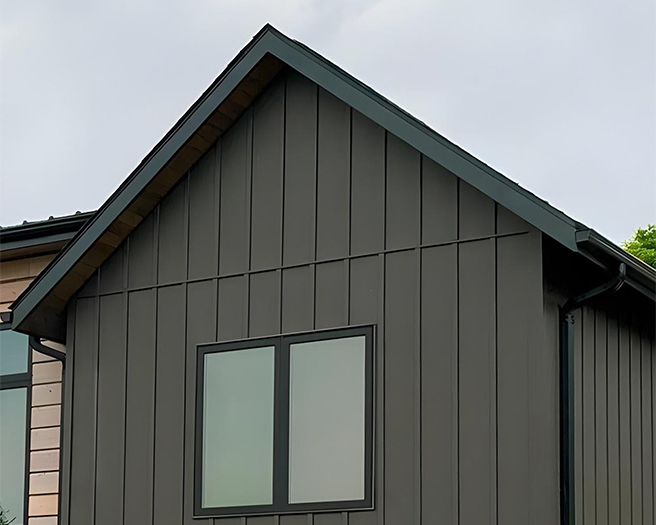
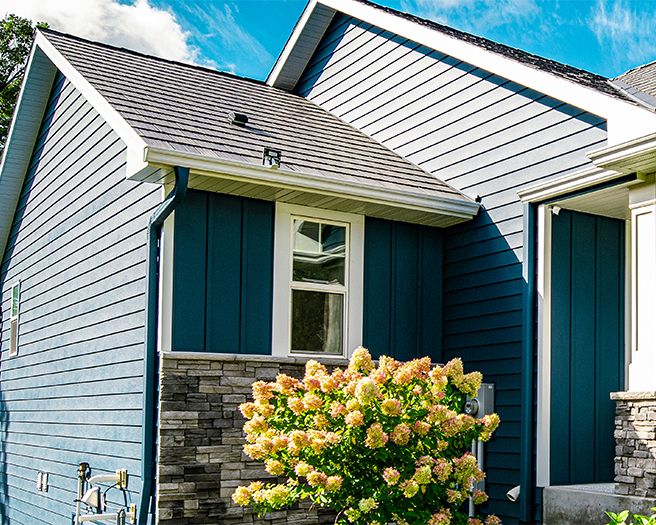
Photos courtesy of Westman Steel Industries
Commenting on trending styles, Gardenits described Westman’s 12-inch vertical board and batten as the hottest up-and-comer, because it adds a new look and texture to a home’s exterior.
The uptick in extreme weather events in Canada has prompted more people to choose steel for their home’s cladding, he added. Not only is it recyclable, meeting the needs of the environmentally conscious, but it is also very durable.
Calgary, for instance, has experienced devastating hailstorms that have destroyed the sides of houses, Gardenits stated. However, “steel is harder to dent and won’t be penetrated by hail when installed against a solid wood substrate.”
Devastating forest fires that ravaged parts of the country have spurred requests for more non-combustible products.
“We have seen some major fire events the past few years, throughout British Columbia and, of course, Jasper.” Gardenits said this has even caused insurance companies to push for more non-combustible materials.
The rise in the popularity of steel cladding has nudged Westman Steel Industries to expand its colour palette. Starting in 2025, Westman’s 28-gauge profile will now offer up to 53 shade options, although dark colours and matte finishes are still trending.
Gardenits said designers, contractors and consumers are finding Westman Steel’s seven-eighths inch corrugated siding a very versatile product. “We are even seeing people use it inside homes for interior walls and feature walls, as well as skirting for decking and raised flower beds.”
Consumers also appreciate that steel siding is practically maintenance free and is covered by strong warranties. It’s a “put it up and forget about it” type of product that only needs to be hosed off every now and then.
Commenting on the current tariff situation between Canada and the U.S., Gardenits concluded by pointing out that Westman Steel’s products are Canadian-made, including sourced steel, so he feels they are well positioned to handle continued supply and demand.
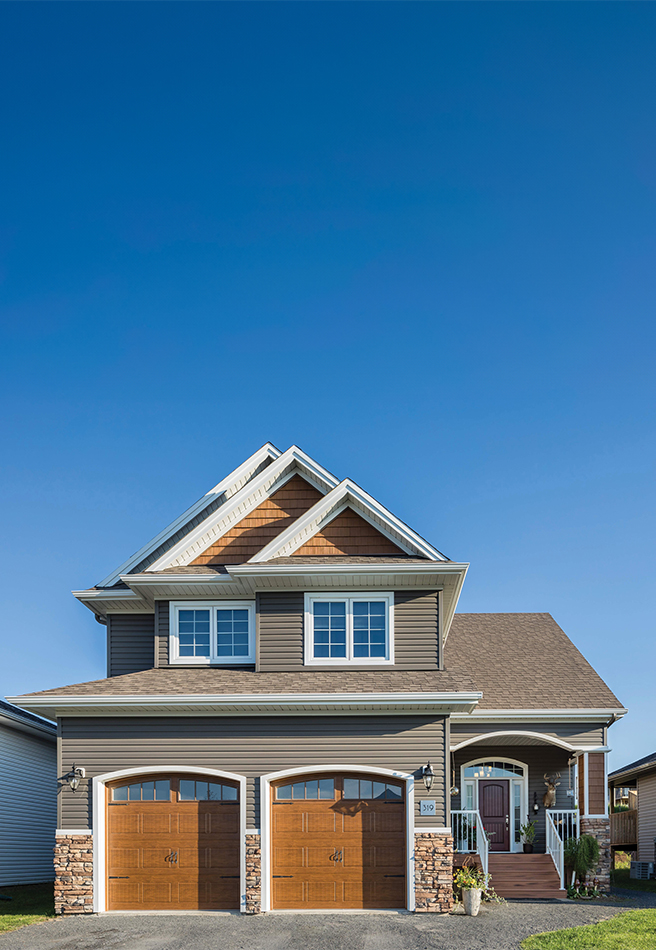
Photo courtesy of Royal Building Solutions
Royal Building Solutions
Royal Building Solutions is a national distributor of exterior building products with 16 locations throughout Canada. Maurizio Scatozza, Regional Manager for Ontario, said the company distributes numerous exterior cladding products, including vinyl, PVC and aluminum siding.
“What has been popular for quite a while is our composite PVC product, Royal Celect,” said Scatozza, adding that its popularity is due to factors including its warranty, durability and resistance to water. Scatozza also noted a rise in the popularity of aluminum siding products with a woodgrain finish. He quickly pointed out that a product’s popularity in Canada is very regional – whereas Central Canada leans toward PVC and aluminum, vinyl products are still strong on the East and West Coasts.
Regional weather also plays a factor in a consumer’s decision-making process. On the East Coast, it is important to have a product that is impervious to water, like vinyl or PVC. “You are dealing with a lot more moisture content due to the rain and ocean factor.”
Dark colours, especially greys, are still trending in 2025 for Central and Western Canada, although warmer brown tones are being reintroduced, especially out West, noted Scatozza. He feels the warm tones are tied to homeowners’ desire to connect with the surrounding nature when designing or remodeling their homes. However, he did point out that in the East, lighter colours are still going strong.
“The great thing about vinyl siding is that the colour tint is integrated into it during the vinyl production, so it’s in the body of the siding,” he said.
As for siding profiles, vertical board and batten has continued to catch consumer attention, with wider board widths leading the charge. Currently, Royal’s 11-inch board and batten profile is in greater demand than the eight-inch product. “I think it is touching on the historical and traditional look that is reminiscent of the board and batten from hundreds of years ago.”
Ultimately, homeowners do their homework when searching for a new siding product, said Scatozza, who feels a broad colour palette and extensive warranties are two major deciding factors when consumers choose exterior cladding.
Vicwest
Founded in Victoriaville, Que., in 1930, Vicwest manufacturing and distribution has eight facilities across the country.
“In the roll form steel space, we are the only true coast-to-coast manufacturer in Canada,” said Brian Glen, Vicwest’s Director of Sales for Canada.
Vicwest’s Bellara siding, originally released as an architectural panel intended for use in institutional, commercial and industrial applications, is now a staple in the residential sector, noted Glen. With three sizes available in the plank series and numerous solid and woodgrain finish options, he feels “it has given architects and designers a chance to be more creative.”
Vertical application is trending in board and batten, but consumers may opt to combine more than one media. For example, they could use vertical plank alongside lap siding, allowing them to “wrap the entire house in steel,” said Glen. He added that consumers are also drawn to how well products perform and their ease of installation.
“With a 40-year warranty on our Bellara products and minimal maintenance, you rarely have to think about it.”
Glen says a woodgrain finish is definitely on trend, especially in feature pieces for the front of homes. In a plank look for the whole home it is picking up momentum, especially vertically-installed board and batten. As far as width of the plank goes, “that five and a quarter inch is still the top performer with 26-gauge being typical for residential application,” he remarked.
From an application standpoint, steel siding requires minimal tools and experience.
“It goes right to a hard deck or substrate, whether it be OSB or plywood.” He feels this appeals to consumers, while the ease of shipping and stocking, thanks to a set length-boxed program, appeals to retailers.
Glen said Vicwest is aligned with consumers when it comes to producing and sourcing sustainable building products. The company’s Planet Passionate initiative embodies that commitment. Company vehicles are now entirely electric, two plants make use of solar energy, LED lighting has replaced fluorescent, and rainwater is harvested for non-potable consumption. He said about 65 percent of the steel procured by Vicwest is recycled and at the end of its current useful lifetime, the product can be fully recycled again.
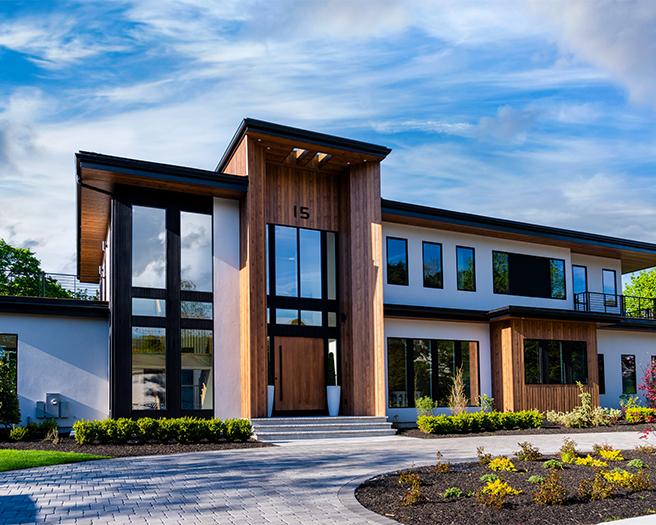
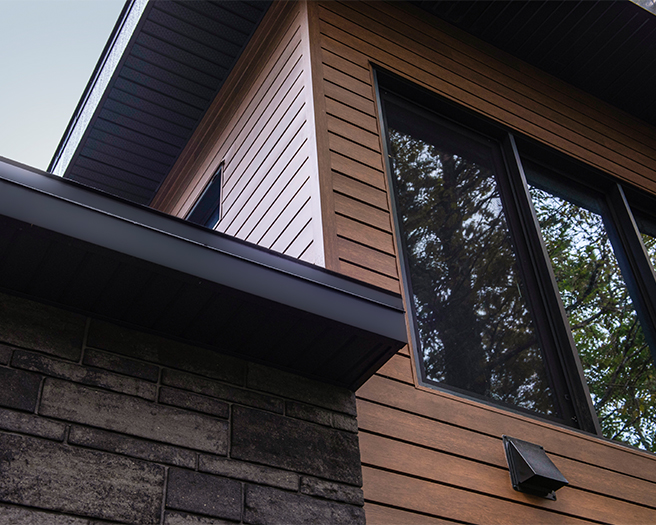
Photos courtesy of Vicwest
Kaycan Ltd.
Founded in 1974, Kaycan Ltd. has 30 distribution centres across Canada. As the company’s Vice President of Retail Sales in Canada, Wade O’Reilly has closely watched trends for the North American manufacturer and distributor of exterior building products.
There are colours and profiles to consider when discussing siding trends, O’Reilly explained. Colours are trending towards darker hues with black trim accessories; while in profiles, board and batten style vinyl siding is trending. Board and batten helped rejuvenate a lighter coloured home with darker trim, he said, but noted that in the last year or so, darker colours have gained popularity. “We are seeing darker reds, greens, blues, browns and greys.”
This year, Kaycan expanded its line of dark colours in board and batten. Colour depth is a personal choice and often it is defined by the territory, O’Reilly offered.
“The East Coast has always been more colourful, but it is catching on across the country, just not to the same extent.” In the accent market, black is dominating, he added.
O’Reilly has also noticed several types of cladding being used on a residential project. He says it is not uncommon to see sections of stone with board and batten on the same home. Vinyl shakes are becoming more popular, too. He has also seen consumers, especially in B.C., using Kaycan’s Urbanix product, an aluminum accessory used for vertical or horizontal accents. The product comes in solid colours with darker colours trending, but woodgrain finishes are also an option.
Stone siding veneer is another product being used as an exterior accent, explained O’Reilly. “You have your areas on the exterior that are able to take stone; it’s mostly accents, there are not many full stone homes anymore.”
Another accessory category where O’Reilly has seen growth is restoration millworks. He says that category includes mostly vinyl trims and accessories that are used around features like windows and doors to enhance the curb appeal of a home. “The restoration millworks category has been growing tremendously; it’s huge right now.”
Vinyl leads the way in siding and has been the traditional choice for most Kaycan-supplied homes, with its aluminum product mostly used for accents like soffits, fascia and gutters. O’Reily also sees aluminum used in verticals, typically higher up on a gable end.
Looking ahead, he tagged a possible interesting development in the siding industry.
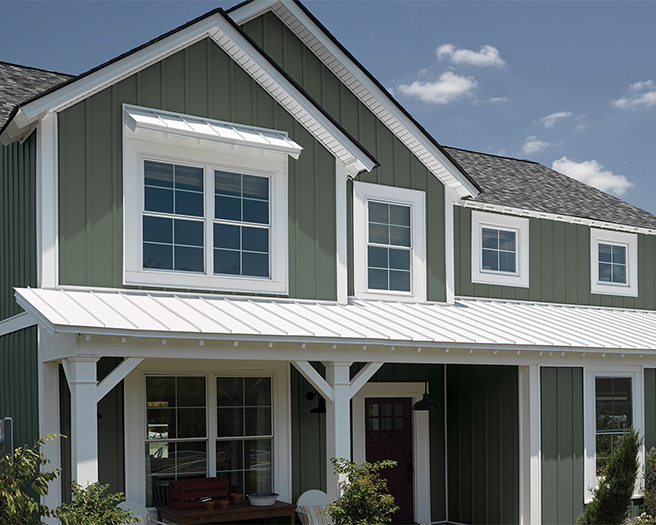
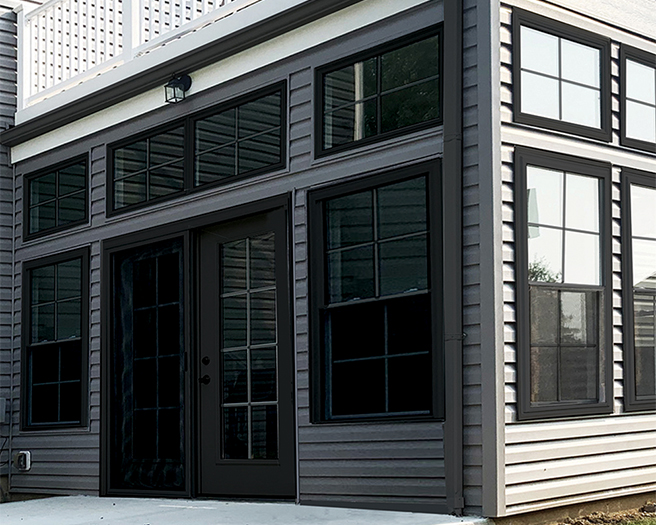
Photos courtesy of Kaycan Ltd.
“We are the first company to manufacture a solid black vinyl extrusion window,” he shared.
O’Reilly said that black manufactured windows are typically painted black – but if they are scratched, the white underneath can show through. O’Reilly feels this new technology is a game changer; he sees it being adapted for use in restoration millwork and also for vinyl siding.
“In vinyl siding, there is not much in black. Now, we have the ability to do a black vinyl siding that we can warrant – it is something I can see coming in the near future.”
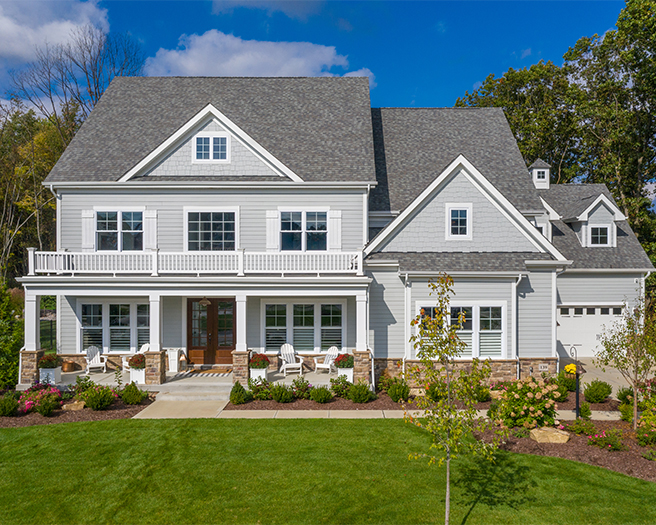
Photo courtesy of Doman Building Materials
James Hardie
“James Hardie is a global leader in the manufacture of fibre cement products,” says Matt Logan, the company’s Director of Product Management. With over 130 years of experience, James Hardie provides residential and light commercial building materials to suppliers in North America, Australia, and several other international markets.
Logan sees several notable trends in the exterior siding market. There is a growing preference for mixed material exteriors, he said, noting that homeowners are combining fibre cement siding with other materials, mainly brick stucco or stone. James Hardie has developed two new products, available in April 2025, to satisfy this trend: Hardie architectural panel and architectural metal trim.
Logan said they are systems that offer a contemporary design solution. “The panels offer nature-inspired, non-wood look textures that elevate the traditional look of stucco.”
These new products will add to Hardie’s lineup, which already consists of Plank Lap siding, Artisan siding, shingle siding and panel vertical siding. With homeowners increasingly researching products themselves and sussing out numerous options, Logan pointed to James Hardie’s “various textures and finishes” as appealing to those who are looking to customize a home’s exterior.
He said fibre cement siding continues to grow market share, partly due to its durability and versatility. The product’s other qualities are also resonating with homeowners, including its “superior performance in the face of weather damage, wildfire risk, and pest infestation.”
Logan feels consumers are searching for products that offer enhanced durability and environmental benefits. He contended that vinyl siding is popular in certain regions, but for those looking for the above-mentioned qualities, “fibre cement stands out as the preferred choice.” He added that composite and metal siding are gaining traction, but projects that fibre cement’s performance and visual appeal will continue to lead the way.
As climate concerns grow across the country, Logan reported a heightened demand for non-combustible products that offer greater protection for homes in wildfire risk zones. He noted that these products are increasingly being integrated into home building and home renovation plans.
“Fibre cement siding is non-combustible, which is a growing priority for consumers, particularly in areas prone to wildfires,” he concluded.
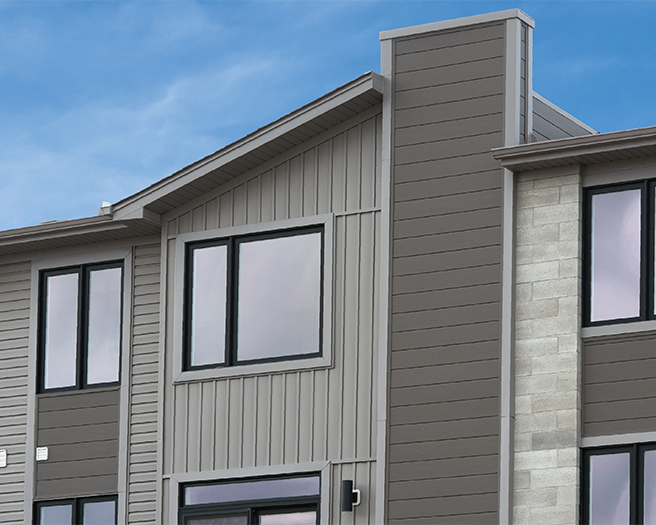
Photo courtesy of Mitten
Cornerstone Building Brands
Mitten and MAC Metal Architectural provide a diverse range of exterior siding solutions, according to Kim Willins, Director Retail Sales & Distribution for Cornerstone Building Brands.
Mitten, founded in 1959, is a Canadian manufacturer and distributor of vinyl and exterior building products. More recently, Cornerstone Building Brands acquired MAC Metal Architectural in 2023, a Quebec-based manufacturer that supplies pre-painted steel siding and roofing products.
“We are North America’s largest manufacturer of exterior building products,” said Willins.
Mitten vinyl siding continues to be a top seller. Willins related the popularity of their vinyl product to its durability, low maintenance and cost-effective value. Add to that a broad selection of profiles and the “largest colour palette in the industry,” and the West Ridge™, Sentry™ and Oregon Pride™ collections remain popular.
Willins said steel siding appeals to those looking for a more luxurious, modern appearance with exceptional durability. MAC Metal Architectural’s Harrywood Plus, Board & Batten and PolyMac are leading the way for Cornerstone in the Canadian steel siding market.
Board and batten is trending as homeowners continue to embrace modern farmhouse and contemporary architectural styes. Willins said Mitten’s eight-inch vinyl plank is a unique offering in the vinyl market for its profile and ability to be installed flat against a wall. “It can be installed horizontally, vertically and as a porch ceiling.”
Vertical siding applications are surging in popularity, although horizontal siding remains the standard, observed Willins. Dutchlap and Clapboard are widely used in new build homes and renovation projects. Mixed materials and textures are also increasing in popularity, Willins added.
“Homeowners are blending vinyl, metal, stone and woodgrain finishes to create visually dynamic exteriors.”
No matter the style of siding application, dark and bold colours are trending. She sees market popularity in shades of dark blue and grey. Woodgrain finishes are also high in demand, where rustic tones mixed with dark bold colours can create a modern, but warm, aesthetic.
Vinyl siding continues to be the most widely used material in Canada, but metal is on the rise, particularly in high-end and modern home designs, Willins commented. Advances in fade-resistant technology, impact resistance, and rigidity continue to make vinyl a strong choice, whereas steel is lauded for its unmatched durability and an elevated aesthetic appeal.
“Matte and textured finishes are increasingly preferred over high-gloss options, as they enhance the depth and realism of woodgrain metal siding,” she said.
Durability and long-term value remain top priorities as buyers are increasingly looking for locally-made, Canadian-manufactured products. Homeowners are also seeking eco-friendly options.
“Sustainability is a key factor driving purchasing decisions,” concluded Willins.
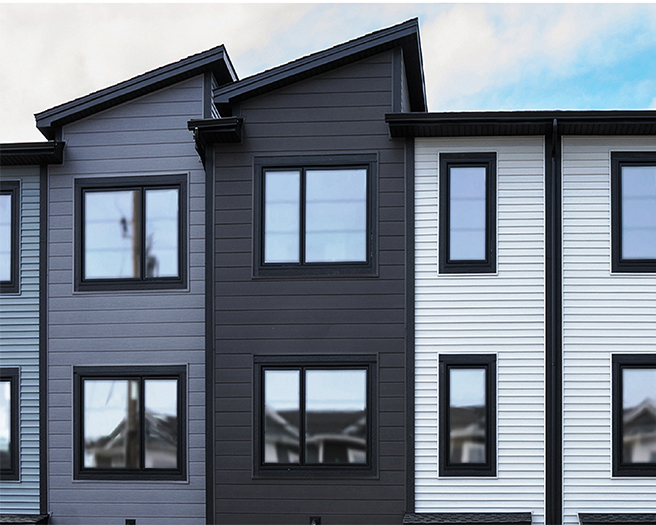
Photo courtesy of Mitten
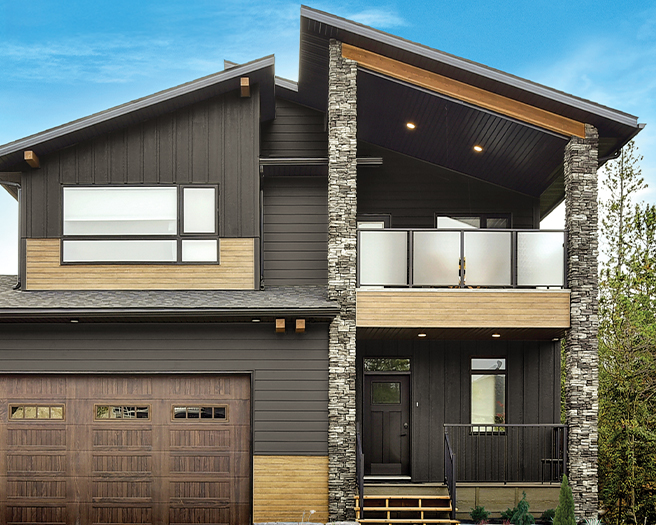
Photo courtesy of Gentek
Gentek Canada
With over 50 years of manufacturing expertise, Gentek offers an extensive range of products, including vinyl, aluminum and steel siding, soffit systems, trim accessories, and residential and light commercial windows. With a coast-to-coast reach, Gentek operates three manufacturing facilities in Canada, as well as 22 supply centres for residential and commercial building solutions.
“Proudly supporting the Made in Canada campaign, Gentek is committed to Canadian craftsmanship,” said Philippe Bourbonniere, President of Gentek Canada Building Supplies.
Homeowners have become increasingly focused on three aspects when choosing a siding product, according to Bourbonniere. Sustainability, energy efficiency and aesthetic variety are top of mind as consumers seek long-term value with low maintenance.
“It’s clear that consumer demand is evolving toward more customizable, sustainable and energy-efficient siding options.”
Home design is playing a key role as homeowners comb through siding design styles. “One of the most noticeable trends is a growing preference for board and batten vertical siding,” Bourbonniere stated. Vertical siding offers a more contemporary and sleeker look that’s becoming increasingly popular, especially for modern-style homes. However, horizontal siding remains a staple, especially for more traditional and classic home designs.
Vinyl siding is still the preferred choice for a majority of homeowners, due to its timeless appeal and versatility. Bourbonniere has noticed a “shift toward larger, bolder profiles in horizontal siding,” like Gentek’s seven-inch Align Composite Cladding plank. He feels the wider design suits homeowners desiring a more updated, robust appearance while still maintaining that familiar, classic feel.
In addition to style preferences, homeowners are also placing more emphasis on energy-efficient options. There is a growing desire for homes that are both smart and efficient, noted Bourbonniere. For those consumers, he offered insulated vinyl siding as a solution to enhance the home’s thermal performance, while helping to reduce energy costs and increase comfort. “This is particularly important in colder regions of Canada, where energy efficiency is a priority.”
Bourbonniere indicated an increasing shift toward wood alternatives in the siding realm. He said that although natural wood siding is still appreciated for its warmth and beauty, wood alternatives provide the look of wood with greater durability and less maintenance, which is appealing to the modern consumer. This category would include composite and engineered wood products, such as fibre cement and vinyl-clad wood, he indicated. “They combine aesthetics with performance, while being a more cost-effective and low-maintenance alternative to traditional wood siding.”
Customization is another key factor, Bourbonniere stated. Homeowners want siding that reflects their personal style, with a wide variety of colours, textures and finishes. On top of that, consumers are becoming more and more educated about the long-term value of the products they choose. Sustainability – in terms of energy efficiency and the materials used in construction – is now at the forefront of many decisions, he remarked.
“Consumers are increasingly conscious of the environmental impact of the products they purchase, and they’re looking for solutions that offer both beauty and responsibility.”
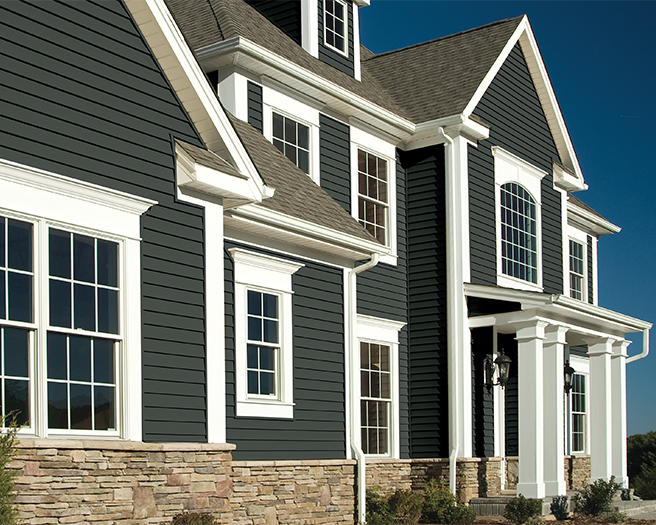
Photo courtesy of Gentek
Conclusion
For 2025, wider and bolder is trending. Whether it’s a vertical or horizontal siding application, consumers are looking for a modern twist to even the most contemporary design.
Homeowners want increased curb appeal and a customized appearance, while having an eye on sustainability. Although regional preferences exist, dark colours remain the top choice in siding, with woodgrain finishes starting to appeal to those searching for a warm, naturally inspired finish that connects with the surrounding environment. —
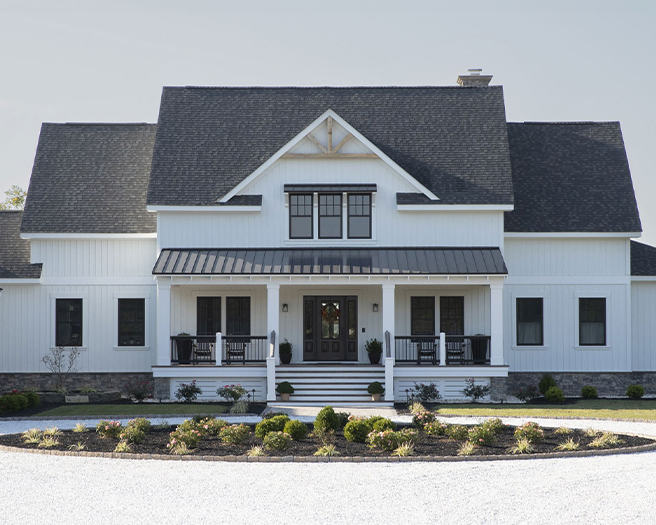
Photo courtesy of Royal Building Products
